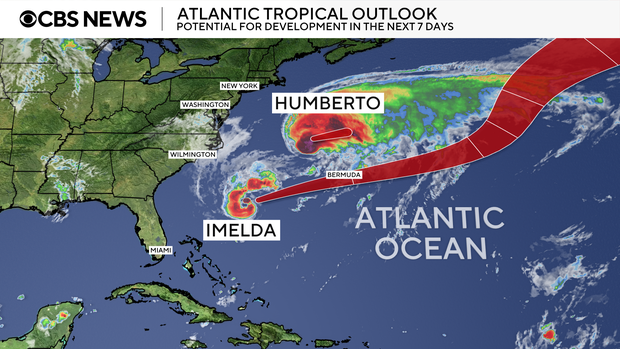The outer bands of distant remnants of Hurricane Humberto lashed Bermuda on Tuesday ahead of a more direct pass from the newer and stronger Hurricane Imelda on the tiny British territory.
Imelda had maximum sustained winds of 100 mph Wednesday and its center was expected to be near the island by evening, the U.S. National Hurricane Center in Miami said.
CBS News
A hurricane warning for Bermuda was in effect ahead of Imelda.
“I cannot overstate the seriousness of this threat,” said Michael Weeks, Bermuda’s minister of national security. “This is not, I must stress, a passing squall.”
He said Bermuda would endure sustained hurricane-force winds for up to six hours starting late Wednesday.
The island’s international airport, schools and government offices were to close Wednesday, and Weeks said residents should have all storm preparations completed by noon.
“Imelda has the potential to damage and disrupt our island significantly,” he said.
Bermuda is a wealthy British territory with strong concrete structures capable of withstanding serious storms.
Far northwest of the island, Humberto diminished over the Atlantic, losing its former hurricane strength.
Both storm system were creating ocean swells that were likely to cause dangerous surf conditions on Bermuda, the Bahamas and the U.S. East Coast. Several unoccupied houses along North Carolina’s Outer Banks collapsed into the ocean Tuesday as wave after wave rolled in from the Atlantic.
Earlier this week, Imelda battered eastern Cuba, killing two people, according to Prime Minister Manuel Marrero. Flooding and landslides also cut off communities and forced evacuations, according to state media.
Imelda also flooded parts of the Bahamas on Monday, with New Providence hit hard. More than a dozen public schools on that island and on nearby Grand Bahama and Abaco remained closed on Tuesday.
“The aftermath is serious,” Prime Minister Philip Davis said. “Floodwaters remain.”
Imelda, which reached hurricane strength on Tuesday, is the Atlantic season’s fourth hurricane this year.
The National Oceanic and Atmospheric Administration (NOAA) had predicted an above-normal season with 13 to 18 named storms. Of those, five to nine were forecast to become hurricanes, including two to five major hurricanes, which pack winds of 111 mph or greater.
The Atlantic hurricane season runs from June 1 to Nov. 30.
Source link


